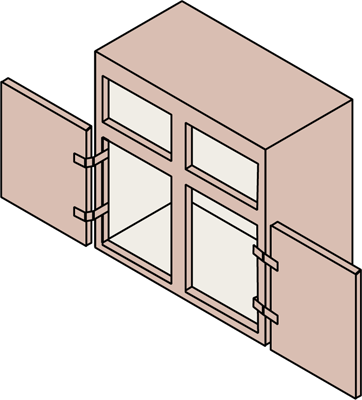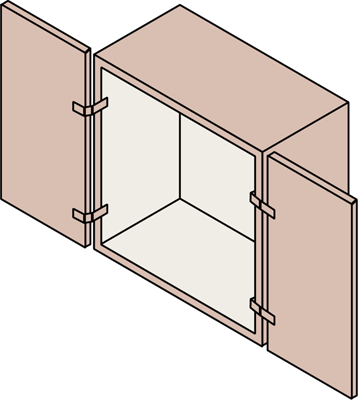How to Measure and Calculate for New Fronts
Anatomy of a Cabinet
Before you proceed, determine whether your cabinets are framed or frameless. Framed cabinets have a frame on the front of the cabinet, while frameless do not.
How to Measure and Calculate for Framed Cabinets
You’ll Need:
- Tape Measure
- Pencil
- Paper
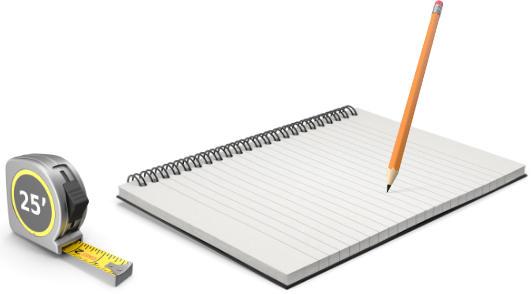
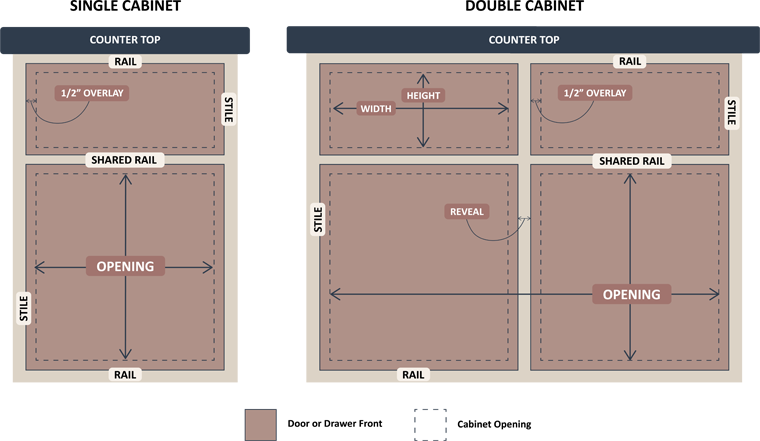
Stile is the vertical piece used in the frame of a cabinet.
Rail is the horizontal piece used in the frame of a cabinet. A Shared Rail is when 2 fronts, such as 2 drawer fronts, cover the same rail.
Reveal is the space (or gap) between doors and/or drawer fronts.
Overlay is the amount of cabinet face frame that is covered by the door or drawer front. Your door overlay and the hinge overlay will match.
Pro Tip
Many professional installers will convert the kitchen to an 1-1/4” overlay to cover up more of the cabinet surface during a refacing project. They are trained to look out for unique areas where 1-1/4” hinges will not work, such as corner cabinets or a cabinet butted up to a wall. For the typical DIYer, we recommend sticking with ½” overlay to reduce the risk of errors.
Sketch the Kitchen
Start by drawing a simple sketch of the kitchen layout. This will help you keep track of measurements and easily match each new door or drawer front with the correct opening during install.
Next, number the openings on your drawing. Start with the upper left doors, then the lower left doors. Then number the drawer fronts, also starting on the left side.
Write down the location of the hinges (left or right) on each door.
(See Fig. 2)

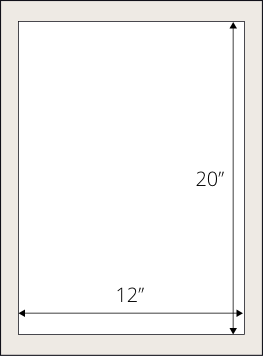
Single Cabinet Opening
Measurements should always be width x height in inches. Round to the nearest 1/16″ (0.0625″).
Open your cabinets and measure the width and height of the frame’s opening. Make note of these measurements on your drawing.
To calculate the door size you need, you’ll add 1/2″ to each side and top and bottom to account for your 1/2″ overlay. In other words, add 1″ to your width and height dimensions.
Ex: 12″ x 20″ cabinet opening, order a 13″ x 21″ door. (See Fig 3.)
Ex: 37″ x 55″ cabinet opening, order a 38″ x 56″ door.
Ex: 14.25″ x 25.5″ cabinet opening, order a 15.25″ x 26.5″ door.
Double Door Opening
Measure the full width of both openings including the center stile of the face frame and make note of the dimension on your drawing. Measure the height of the cabinet opening and make note on your drawing. To calculate the door width, add 1″ to account for the 1/2″ overlay on the left and right hinge sides, divide by 2 to get to the width of your 2 doors. To ensure the cabinet doors don’t touch when closed, now subtract 1/16″ from each door.
To calculate the height, add 1″ to account for 1/2″ overlay on the top and bottom.
Example (see Fig. 4):
Width: 36″ + 1″ = 37″
37″ ÷ 2 = 18.5″
18.5″ – 0.0625″ = 18.4375″
Height: 25″ + 1″ = 26″
Order two 18.4375″ x 26″ doors

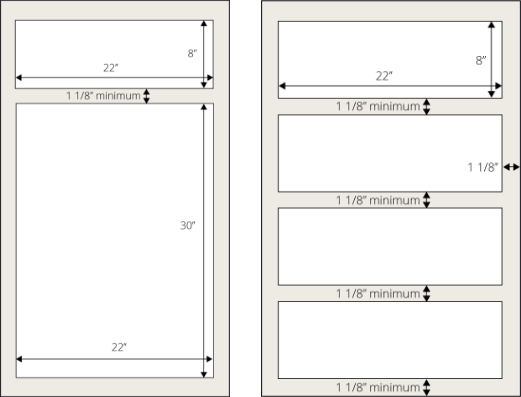
Drawer + Door Combos or Bank of Drawers
To accurately measure drawer openings, it can be helpful to remove the drawer box. Measure the width and height of your opening plus the shared rails between openings and make note on your drawing. To calculate the drawer sizes, add 1” to the width and height to account for 1/2″ overlay on each side. Please note, you need a minimum 1 1/8″ shared rail between each opening for this formula to work.
If the shared rail is less than 1 1/8″, you will need to calculate what overlay will work for your shared rail. The formula is: Rail height divided by 2 minus 1/16″.
Make sure you use the same measurements for a run of cabinets in the same configuration so your doors and drawer fronts line up.
Example (see Fig. 5):
22″ + 1″ = 23″
8″ + 1″ = 9″
Order 23″ x 9″ drawer
22″ + 1″ = 23″
30″ + 1″ = 31″
Order 23″ x 31″ door
Double check your calculations. Your fronts should align horizontally and vertically (i.e. Drawer 1 and 4 should be the same height. Drawers 5 + 6 + the space between them should equal the height of Doors 2 and 3).
You always want to measure and calculate twice, and order once!
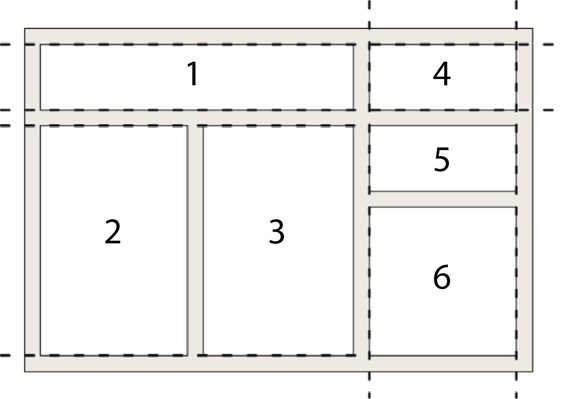
Lazy Susan Doors
You will order your Lazy Susan doors as a set. The hinge side will be drilled for hinges. The handle side will not be drilled.
Measure the width from the inside corner to the edge of the face frame, make note on your drawing. Measure the height of the opening, make note on your drawing.
To calculate the widths, add 1/2″ to overlay the cabinet on 1 side, subtract 7/8″ to account for the thickness of the door where they meet in the middle.
To calculate height, add 1″ to account for the 1/2″ overlay on top and bottom.
Example (see Fig. 6):
Handle Side Width: 12″ + 0.5″ – 0.875″ = 11.625″
Hinge Side Width: 13″ + 0.5″ – 0.875″ = 12.625″
Height: 33″ + 1″ = 34″
Order 11.625″ x 34″ handle side and 12.625″ x 34″ hinge side doors.
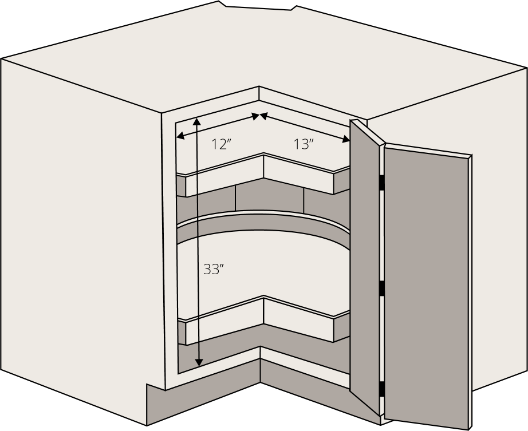
Pro Tip
Measure and calculate (at least) twice, order once! Double-check your measurements and calculations before placing an order.
You can calculate for other overlay sizes, but be sure to order the correct hinges and understand there may be areas in your kitchen where your desired overlay doesn’t work, such as a cabinet right next to a wall. Our friendly customer support staff is here to help if you have any questions as you measure.
How to Measure Frameless Cabinets
You’ll Need:
- Tape Measure
- Pencil
- Paper

Sketch the Kitchen
Start by drawing a simple sketch of the kitchen layout. This will help you keep track of measurements and easily match each new door or drawer front with the correct opening during install.
Next, number the openings on your drawing. Start with the upper left doors, then the lower left doors. Then number the drawer fronts, also starting on the left side.
Write down the location of the hinges (left or right) on each door.
(See Fig. 2)
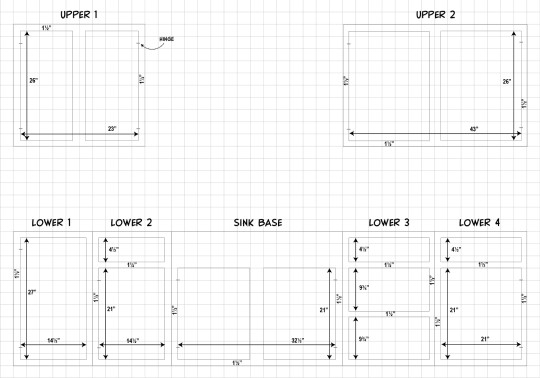
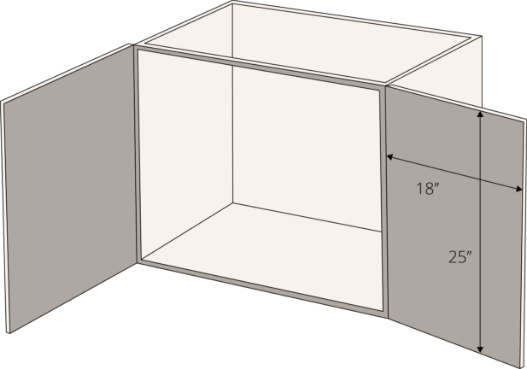
Measure the Existing Doors
With frameless cabinets, there is only one type of hinge that works so you can measure your old doors. Measure the back of the existing doors and drawer fronts by finding the width x height in inches, rounded to the nearest 1/16″ (.0625).
Make sure you measure the back of the door in case it has a bevel or routed edge that could impact your measurement.
Example (see Fig. 7):
Order 18″ x 25″ door



